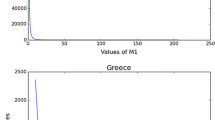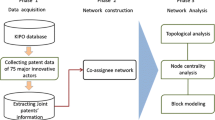Abstract
The aim of this article is to observe differences between research areas when it comes to establish collaboration ties with local, national or international partners. It also intends to determine in what extent the collaboration can influence the patent transfer. A collaboration network between CSIC researchers and their external collaborators was built. Several statistical tests were used to find significant differences between research areas. A multiple regression model was also utilized in order to know what type of collaboration is more successful to transfer a patent. The results show that there are two well defined groups. A “Bio” group with a high international collaboration pattern but less national participation; and a “Physicist” group supported by a high proportion of national partners but with few international connections. The regression analysis found that the national collaboration is the variable that most increase the patent transfer.
Similar content being viewed by others
References
Agrawal, A. (2000). Importing scientific inventions: Direct interaction, geography and economic performance. Mimeo, Massachusetts Institute of Technology.
Balconi, M., Breschi, S., & Lissoni, F. (2004). Networks of inventors and the role of academia: An exploration of Italian patent data. Research Policy, 33, 127–145.
Boccardelli, P., Leone, M. I., Magnusson, M., & Reichstein, T. (2010). Fuel on the invention funnel: Technology licensing-in, antecedents and invention. [working paper]. Aalborg: DRUID. http://www3.druid.dk/wp/20100013.pdf.
Bordons, M., & Gomez, I. (2000). Collaboration networks in science. In B. Cronin & H. B. Atkins (Eds.), The web of knowledge: A festschrift in honor of Eugene Garfield. NJ: Information Today.
Boyack, K. W., Klavans, R., & Börner, K. (2005). Mapping the backbone of science. Scientometrics, 64(3), 351–374.
CSIC. (2006). Plan de Actuación 2006–2009. Madrid: CSIC.
Dunn, O. J. (1961). Multiple comparisons among means. Journal of the American Statistical Association, 56, 54–64.
Frame, J. D., & Carpenter, M. P. (1979). International research collaboration. Social Studies of Science, 9(4), 481–497.
Godoe, H. (2000). Innovation regimes, R&D and radical innovations in telecommunications. Research Policy, 29, 1033–1046.
Goktepe, D. (2006). Identification of university inventors and university patenting patterns at Lund University: Conceptual, methodological & empirical findings. Copenhagen, Denmark: DRUID winter conference. http://mpra.ub.uni-muenchen.de/1628/1/MPRA_paper_1628.pdf.
Hagstrom, W. O. (1965). The scientific community. New York: Basic Books.
Hansen, M. T. (1999). The search-transfer problem: The role of weak ties in sharing knowledge across organization subunits. Administrative Science Quarterly, 44, 82–111.
Katz, J. S., & Martin, B. R. (1997). What is research collaboration? Research Policy, 26(1), 1–18.
Kruskall, W. H., & Wallis, W. A. (1952). Use of ranks in one-criterion variance analysis. Journal of the American Statistical Association, 47(260), 583–621.
Lee, Y. G. (2009). What affects a patent’s value? An analysis of variables that affect technological, direct economic and indirect economic value: An exploratory conceptual approach. Scientometrics, 79(3), 623–633.
Lissoni, F., Llerena, P., McKelvey, M., & Sanditov, B. (2008). Academic patenting in Europe: New evidence from the KEINS database. Research Evaluation, 17(2), 87–102.
Lissoni, F., & Montobbio, F. (2008) Guest authors or ghost inventors? Inventorship attribution in academic patents. The 25th DRUID celebration conference 2008 on entrepreneurship and innovation, Copenhagen, Denmark. http://www.econ.kuleuven.be/msi/_docs/workshops/2008-04-24.pdf.
Lowe, R. A. (2002). Entrepreneurship and information asymmetry: Theory and evidence from the University of California. Working paper. 11/25/02, http://littlehurt.tepper.cmu.edu/gsiadoc/wp/2003-09.pdf.
McCarthy, J. T., Schecter, R. E., & Franklyn, D. J. (2004). McCarthy’s desk encyclopedia of intellectual property (3rd ed.). Washington: The Bureau of National Affairs.
Meyer, M., & Bhattacharya, S. (2004). Commonalities and differences between scholarly and technical collaboration: An exploration of co-invention and co-authorship analyses. Scientometrics, 61(3), 443–456.
Mowery, D. C., & Ziedonis, A. A. (2001). The geographic reach of market and non-market channels of technology transfer: Comparing citations and licenses of university patents. NBER working paper series, w8568. http://dimetic.dime-eu.org/dimetic_files/MoweryZiedonis2004%20University%20Licenses%201.pdf.
Ortega, J. L., & Aguillo, I. F. (2010). La participación española en los programas europeos: Análisis estructural del área de salud del 6º Programa Marco. Revista Española de Documentación Científica, 33(2), 287–297.
Powell, W. W., & Grodal, S. (2004). Networks of innovations. In J. Fagerberg, D. Mowery, & R. R. Nelson (Eds.), The oxford handbook of innovation. Oxford: University Press.
Price, D. J. de S. (1986). Little science, big science…and beyond. New York: Columbia University Press.
Sapsalis, E. (2007). From science to license: An exploratory analysis of the value of academic patents, working papers CEB 07-018.RS, Universite Libre de Bruxelles. https://dipot.ulb.ac.be:8443/dspace/bitstream/2013/53932/1/RePEc_sol_wpaper_07-018.pdf.
Vinding, A. L. (2002). Interorganizational diffusion and transformation of knowledge in the process of product innovation, Ph. D. thesis. Denmark: Aalborg University http://www.business.aau.dk/~alv/Vinding-Dissertation.pdf.
Yoshikane, F. (2006). Comparative analysis of co-authorship networks considering authors’ roles in collaboration: Differences between the theoretical and application areas. Scientometrics, 68(3), 643–655.
Author information
Authors and Affiliations
Corresponding author
Rights and permissions
About this article
Cite this article
Ortega, J.L. Collaboration patterns in patent networks and their relationship with the transfer of technology: the case study of the CSIC patents. Scientometrics 87, 657–666 (2011). https://doi.org/10.1007/s11192-011-0363-4
Received:
Published:
Issue Date:
DOI: https://doi.org/10.1007/s11192-011-0363-4




